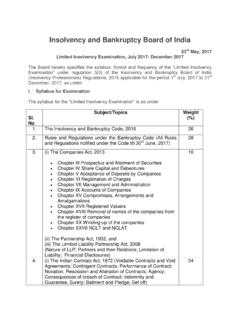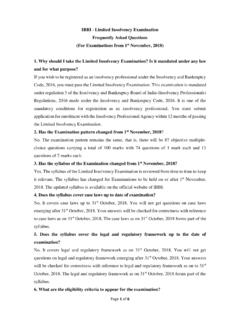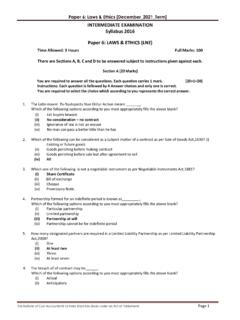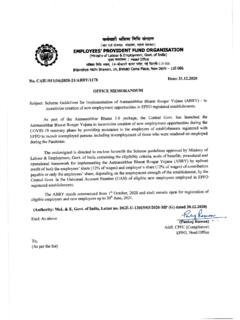Transcription of MODEL QUESTION PAPER FOR VALUATION EXAMINATION …
1 MODEL QUESTION PAPER FOR VALUATION EXAMINATION IN THE ASSET CLASS: SECURITIES OR FINANCIAL ASSETS (BASED ON REVISED SYLLABUS WITH EFFECT FROM 1st JUNE 2020) 1. The national output is measured at which of the following price? a. Production price b. Market price c. Cost prices d. Wholesale prices Ans. (b) 2. Which of the following relation between fiscal deficit (FD) and primary deficit (PD) is correct? a. PD = FD - depreciation b. PD = FD - interest payments c. FD = PD - interest payments d. FD = PD - depreciation Ans. (b) 3. Quantitative easing is an unconventional monetary policy in which a central bank purchase government securities or other securities from the market in order to____. a. rise interest rate and increase the money supply in the economy b. lower interest rate and decrease the money supply in the economy c. lower interest rate and increase the money supply in the foreign economy d. lower interest rate and increase the money supply in the economy Ans.
2 (d) 4. An investment pays Rs. 300 annually for five years, with the first payment occurring today. The present value (PV) of the investment discounted at a 4% annual rate is approximately _____. a. 1336 b. 1389 c. 1625 d. 1925 Ans. (b) 5. Which of the following measures does not take into account the time value of money? a. Payback period b. Net present value c. Internal rate of return d. Discounted cash flow Ans. (a) 6. If a firm has a P/E ratio of 15, and a ROE of 14 %, what is the market to book value of equity? a. b. c. d. Ans. (b) 7. The formula, long-term debt divided by (long-term debt plus shareholders' equity) determines the _____ of a company. a. Debt ratio b. Debt to equity ratio c. Capitalisation ratio d. Profitability index Ans. (c) 8. Which of the following is not a cash outflow? a. Increase in prepaid expenses b. Increase in debtors c. Increase in stocks d. Increase in creditors Ans.
3 (d) 9. Which of the following statements is not true regarding Cash and Cash equivalents in a cash flow statement? a. Cash comprises cash on hand and demand deposits with the bank b. Cash equivalents are short-term in nature c. There is an insignificant risk of change in value of cash equivalents d. Cash equivalents are highly illiquid investments Ans. (d) 10. Which of the following is not a conduct most people associate with ethical behaviour? a. Bribing b. Negotiating c. Advocating d. Lobbying Ans. (a) 11. As an independent valuer, the valuer should not charge_____fee. a. professional b. success c. mandate d. legal Ans. (b) 12. Professional independence is a subset of which one of the following pairs of fundamental principles? a. Integrity and due diligence b. Integrity and objectivity c. Due diligence and professional competence d. Objectivity and due diligence Ans. (b) 13. Which of the following would not be included in Valuer`s Engagement Letter?
4 A. Timeline of the engagement b. Management`s responsibilities with respect to financial records and accuracy of information c. Terms of payment d. Management representation Ans. (d) 14. Which of the following capital is not shown in a company`s balance sheet? a. Reserve capital b. Authorised Capital c. Issued and Subscribed Capital d. Called and paid up capital Ans. (a) 15. A Tribunal makes an order under section 230 of the Companies Act, 2013 sanctioning a compromise or an arrangement in respect of a company. In this context, which of the following cannot be true? a. It will supervise the implementation b. It can give order for winding up of the company c. It can modify the order or compromise d. It can ask for creditors responsibility statement Ans. (d) 16. Who is the authority for registration of valuers under the Companies (Registered Valuers and VALUATION ) Rules, 2017? a.
5 MCA b. NFRA c. IBBI d. NCLT Ans. (c) 17. Which of the following is not eligible to be registered as a valuer? a. Registered partnership firm b. Limited liability partnership c. Limited liability company d. Hindu undivided family Ans. (d) 18. Which of the following can be transferred under the Transfer of Property Act, 1882? a. An easement along with the dominant heritage b. Political pension c. Succession d. Stipends allowed to the civil pensioners of the Government Ans. (a) 19. A leases land to B on condition that he shall walk a hundred miles in an hour. The lease is _____. a. valid b. void c. voidable d. legal Ans. (b) 20. How is stamp duty paid in transactions where more than one instrument is required? a. Stamp Duty is paid on all the instruments equally b. Stamp Duty is paid on any one of the instrument c. Stamp duty is paid only on one of the principal instruments and on the balance documents only minimum duty is payable d.
6 Stamp duty is paid on ad valorem basis Ans. (c) 21. As per section 40(b) of the Income Tax Act, 1961, up to ____ % per annum simple interest on capital is allowed towards remuneration of working partners. a. 6 b. 12 c. 15 d. 16 Ans. (b) 22. Salary under section 17(1) of the Income Tax Act, 1961 does not include _____. a. wages b. pension c. interest d. gratuity Ans. (c) 23. The exemption under section 54 of the Income Tax Act, 1961 is available _____. a. to the extent of capital gain invested in the House property b. proportionate to the net consideration price invested c. to the extent of amount actually invested d. to the extent of net consideration Ans.(a) 24. Who determines the amount of claim due to a creditor under the Insolvency and Bankruptcy Code, 2016? a. Committee of creditors. b. Resolution professional. c.
7 Adjudicating authority. d. Corporate debtor Ans. (b) 25. Under the Insolvency and Bankruptcy Code, 2016, debts owed to a secured creditor in the event such secured creditor has relinquished security ranks equally with _____. a. insolvency resolution process costs b. workmen s dues for a period of 24 months prior to liquidation commencement date c. wages and any unpaid dues owed to employees other than workmen for the period of twelve months preceding the liquidation commencement date d. dues to Central Government Ans. (b) 26. Which of the following is not a financial service under the Insolvency and Bankruptcy Code, 2016? a. Accepting of deposits b. Effecting contracts of insurance c. Payment of wages to employees d. Establishing or operating an investment scheme Ans. (c) 27. Under the SARFAESI Act, 2002, the Central Registrar may allow the filing of the particulars of creation of security interest within _____ following the expiry of the period of initial thirty days on payment of additional fee.
8 A. ten days b. thirty days c. twenty-five days d. fifteen days Ans. (b) 28. As per SEBI (ICDR), 2009, which of the following come under qualified institutional buyer: a. A provident fund with minimum corpus of twenty crore rupees. b. A provident fund with minimum corpus of twenty-five crore rupees. c. A provident fund with minimum corpus of fifteen crore rupees. d. A provident fund with minimum corpus of sixty-four crore rupees. Ans. (b) 29. As per SEBI (Share based Employee Benefits) Regulation, 2014, appreciation means the difference between the _____. a. market price of the share of a company on the date of exercise of stock appreciation right (SAR) or vesting of SAR, as the case may be, and the SAR price. b. face value of the share of a company on the date of exercise of stock appreciation right (SAR) or vesting of SAR, as the case may be, and the SAR price. c. market price of the share of a company on the date of exercise of share appreciation right (SAR) or vesting of SAR, as the case may be, and the SAR price.
9 D. face value of the share of a company on the date of exercise of share appreciation right (SAR) or vesting of SAR, as the case may be, and the SAR price. Ans. (a) 30. Which statute governs external commercial borrowing? a. Foreign Exchange Maximization Act, 1972 b. Foreign Exchange Management Act, 1999 c. Foreign Exchange Minimization Act, 2004 d. Foreign Exchange Regulation Act, 1972 Ans. (b) 31. As per the RBI (Prudential Framework for Resolution of Stressed Assets) Directions, 2019 banks shall recognise incipient stress in loan accounts, immediately on default, by classifying such assets as _____. a. non-performing account b. sub-standard account c. standard account d. special mention account Ans. (d) 32. Ind AS 113 defines fair value as the price that would be received to sell an asset or paid to transfer a liability in _____ between market participants at the measurement date. a. an orderly transaction b.
10 A quick transaction c. a purchase transaction d. a sale transaction Ans. (a) 33. As per Ind AS 113 which of the following is not a VALUATION technique? a. Market approach b. Cost approach c. Income approach d. Worth approach Ans. (d) 34. The scope of Ind AS 36 includes impairment of which of the following assets? a. inventories b. financial assets classified as subsidiaries c. deferred tax assets d. assets arising from employee benefits Ans. (b) 35. As per Ind AS 103, accounting for Business Combinations using the acquisition method requires which of the following? a. Identifying the acquirer b. Determining the acquisition date c. Recognising and measuring the unidentifiable assets acquired d. Recognising and measuring any goodwill or bargain purchase Ans. (c) 36. Which of the following statements is true regarding Ind AS 109? a. The standard applies to employers rights and obligations under employee benefit plans b.














